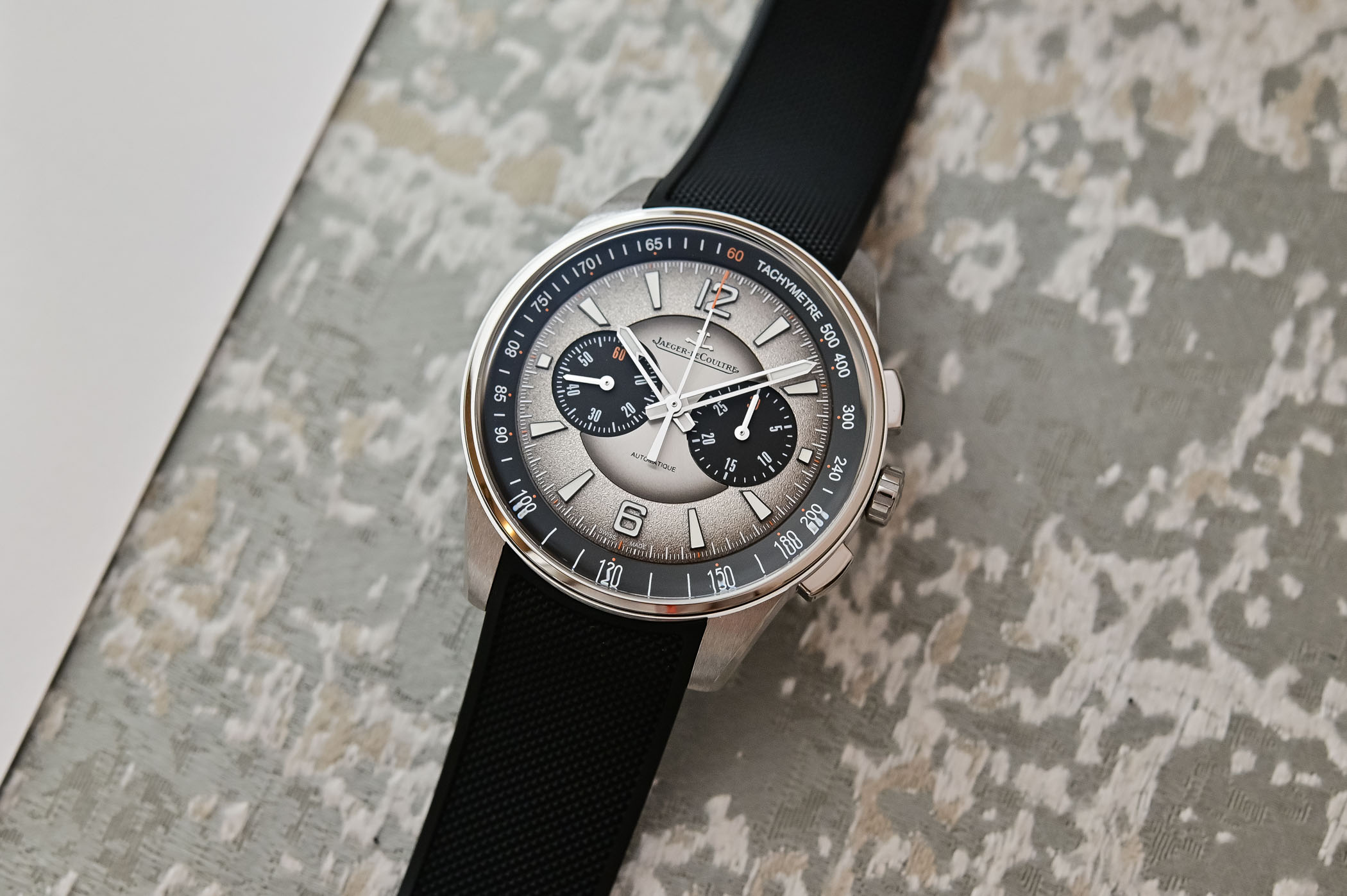The New Gradient Face And Movement Of The Jaeger-LeCoultre Polaris Chronograph
On-trend gradient lacquered dial, subtle design tweaks and an updated movement.

Inspired by the iconic 1968 Memovox Polaris dive watch with its underwater alarm, a modern Polaris collection was released in 2018 by Jaeger-LeCoultre. As the brand’s only sports watch collection, the Polaris Chronograph with its tachymeter bezel to measure speed over a fixed distance is the definitive sporting complication forging a link between JLC and the world of motorsports. Five years down the line, the Polaris Chronograph speeds back on the scene with a dashing gradient grey lacquered dial powered by a new, in-house integrated chronograph movement.
Dashboard instruments
Although we might associate Jaeger-LeCoultre’s sporting credentials with the genteel game of Polo thanks to the Reverso, there is another lesser-known chapter of the brand’s history when Jaeger manufactured cockpit instruments for Allied Forces during WWI. Following the war, Edmond Jaeger and Jacques-David LeCoultre teamed up to produce dashboard instruments for cars, such as tachymetres, speedometers and fuel gauges. You can read all about Brice’s participation in the JLC-sponsored classic car rally, Passione Engadina and the vintage Italian cars bearing Jaeger dashboard instruments.

The New POLARIS CHRONOGRAPH
In a departure from the overtly vintage Polaris Date model that captures the spirit of its 1968 ancestor, the more complex Chronograph, Chronograph WorldTime, and Perpetual Calendar sport more contemporary lines.
The 42mm stainless steel case of the Polaris Chronograph has a thickness of 13.39mm and is defined by taut lines, curved lugs and a thin bezel. Compared to the earlier edition, the case is slightly thicker (13.39mm vs. 11.9mm) due to the new movement powering the watch. Alternating finishings highlight the architecture with its polished bezel, pushers and crown and vertically brushed case middle and lugs with sleek polished bevels. The large crown is a throwback to the 1968 diver, and the water-resistance rating is 100 metres.
Channelling the current trend for gradient dials with granular matte finishings, Jaeger-LeCoultre upgrades the Polaris Chronograph with a handsome, sporty grey lacquered dial. Starting with the sloping tachymetre scale – incorporated on the dial and not the bezel – the number 60 and the dots over the white numerals are accented in orange. The circular chapter ring bearing the hour indices and the central disc are each decorated with grey lacquer that graduates from light to dark as it reaches their respective peripheries. The lacquer is applied by hand – up to 35 coats – and requires great dexterity to achieve the right shade and gradient so that both sections match. Although the gradient effect is perfect, the chapter ring with the hour markers displays a grained, asphalt-like race track surface.
The oversized trapezium-shaped markers and bold Arabic numerals of the iconic 1968 model are revisited on the Polaris Chronograph in a more contemporary key and filled with Super-LumiNova emitting a blue glow. Applied to the dial and outlined for extra relief, the indices shrink in size where the sub-counters invade the chapter ring.
Unlike the earlier edition of the Polaris Chronograph with 12-hour and 30-minute chronograph counters, the new edition respects the bi-compax layout but replaces the 12-hour totaliser at 9 o’clock with a running seconds function. The two counters match the darker grey colour of the tachymetre scale with the numbers 30 and 60 picked out in orange to match the tip of the central seconds chronograph hand and the 5-minute markers. With no date window to distract the eye, the chronograph functions command attention. Another difference with its predecessor is the shape of the hour and minute hands that are now sword-shaped, openworked with green-emitting Super-LumiNova in their tips. The distortions you can see in our photographs that affect the tachymetre scale are produced by the glass-box crystal.
The sapphire crystal caseback reveals the new JLC’s calibre 761, a fully integrated chronograph movement using similar features to the calibre 751 but ditching the 12-hour recorder and adopting a running seconds counter instead. Fitted with a column wheel and a vertical clutch, the movement is designed, produced, finished and assembled at the brand’s manufacture in Le Sentier. With its double-barrel, the movement delivers a 65-hour power reserve for the hours, minutes, small seconds, central seconds indication and 30-minute chronograph counter. The movement is decorated in classic Jaeger-LeCoultre style with Geneva stripes, blued screws, bevelled angles and an openworked rotor.
The Polaris Chronograph is accompanied by two interchangeable straps – a beige canvas strap and a textured black rubber strap with an interchangeable steel folding buckle. There is also a blue dial version (not photographed but check the official JLC images below) with identical specifications but fitted with a stainless steel bracelet and a higher price tag (EUR 16,100).
Availability & Price
The Jaeger-LeCoultre Polaris Chronograph with a grey dial joins the current collection and retails in Europe for EUR 15,500. Please check the brand’s website for the exact price in your location.













2 responses
JAEGER-LECOULTRE POLARIS CHRONOGRAPH 2023 Like everything in the Jaeger-LeCoultre line of watches they are extremely overpriced! Yet, they keep increasing the prices almost monthly on their watches as though increasing the price of their watches makes them better than the competition. Wrong! The JAEGER-LECOULTRE POLARIS CHRONOGRAPH 2023 is too large and of course overpriced. I could purchase a Longine chronograph at one third the price with the same outstanding quality of any of the Jaeger LeCoultre line of watches which would outlast any of the Jaeger-LeCoultre watches and still have money in the bank to purchase two more quality watches.
RAOUL, you have no idea about JLC quality .. also you watch prices from below